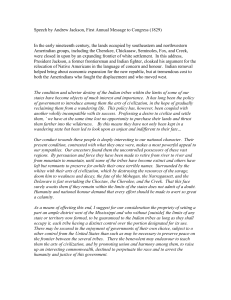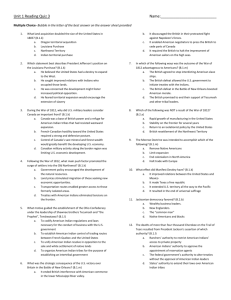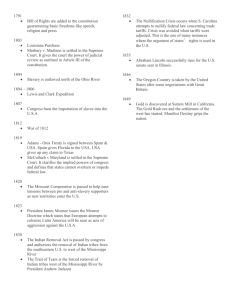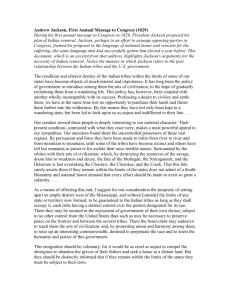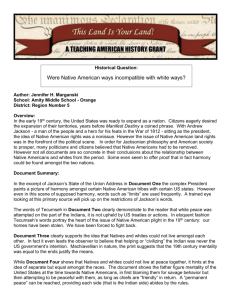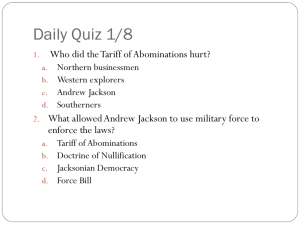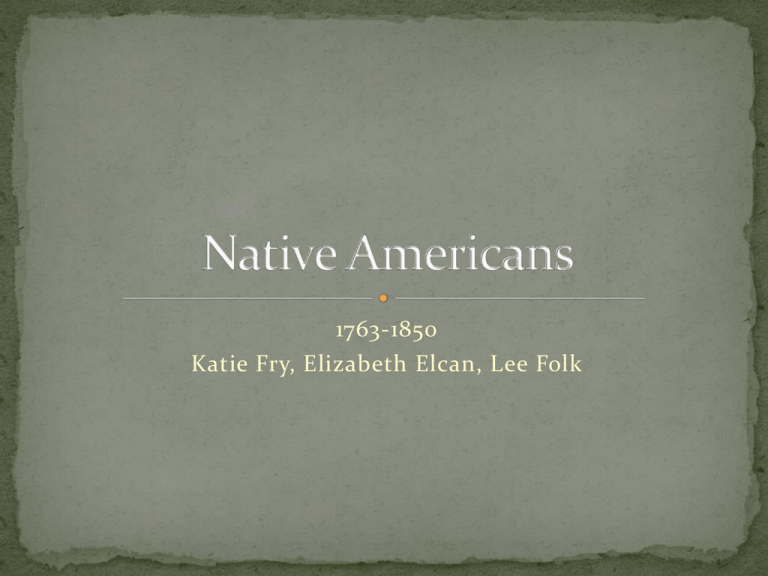
1763-1850
Katie Fry, Elizabeth Elcan, Lee Folk
Native Americans between 1763 and 1850 were not just
kept from achieving the American Dream; they had it
ripped from their hands by ever-expanding,
dishonorable white America.
After the French and Indian war, the Native Americans
realized that they could use European countries as an
ally to hurt the Americans encroaching on their land
in the west, leading to Pontiac’s Rebellion.
http://www1.american.ed
u/ted/ice/frenchindian.htm
Pontiac was a lesser known Ottawa chief who sided
with the French during the French and Indian War.
He was angry when
the British took over
the French forts in the
west after the war.
http://www.libraries.wvu.edu/adamstephen/
Pontiac planned a direct attack on the British Fort
Detroit, but the plan was leaked and when the
warriors came into the fort, the British soldiers knew
what was going on.
After devising a new plan, Pontiac’s men attacked
surrounding farms, killing 3 civilians.
Pontiac pretended to agree to a truce but took the
second in command of the fort hostage.
http://www.burnpit.us/2010/08/battle-of-bushy-run-british-force-defeats-indians-relieve-
After a few months under siege, the British received
supplies and soldiers from Fort Niagara and Pontiac
gave up.
The rebellion of other Native American tribes travelled
to British outposts in the west.
More than 2,000 white settlers were killed during the
rebellion.
The movement ended around 1763.
Pontiac was killed in 1763 by a Peoria warrior.
The uprising was led by a Miami warrior named Little
Turtle.
He fought whites on the western
border of Ohio.
http://www.ohiohistorycentral.org/image.php
?img=960
Over 630 whites were
killed close to the
Wabash River.
Attempts at a treaty were
made but failed.
General Anthony Wayne
brought in 4,000 troops
to the Ohio River Valley
and won an important
victory at the Battle of
Fallen Timbers in 1794.
http://commons.wikimedia.org/wiki/File:
Ohiorivermap.png
http://www.ohiohistorycent
ral.org/entryimages.php?rec=43
Negotiated in 1785, after the Battle of Fallen Timbers.
The Miami tribe was promised that they can keep the
land they occupy.
The other Native Americans gave up their claim to
most of the land in the Ohio River Valley.
Created a temporary solution.
The Iroquois rejected the treaty in 1786.
The American settlers still continued to settle on
westward lands belonging to Native Americans, and
they felt threatened.
The Constitution failed to mention any specific way of
dealing with Native Americans.
They were not counted in the population (Art. 1).
Tribes are legal entities but not foreign countries.
Have no representation in the government.
Article 4 of the Constitution binds the new
government to respect the treaties made by the old
government in reference to Native Americans.
The old government had treaties to take land in the
Northeast and Southeast from Iroquois, Choctaw,
Cherokee and Chickasaw by force.
Brother was Tenskwatawa
(the Prophet).
Technically a Shawnee but
identified himself as an
“Indian.”
Wanted Native American
tribes to unify against whites.
Urged other Indians living in
the area to avoid contact with
whites, resist the temptation
of alcohol, and not allow their
land to be taken.
Killed by William Henry
Harrison in 1813.
http://madmonarchist.blogspot.com/2010/07/monarchist-profilechief-tecumseh.html
“If we are to wage a campaign against these Indians the end proposed
should be their extermination, or their removal beyond the lakes of the
Illinois river. The same world will scarcely do for them and us.”
-Thomas Jefferson
Grew up always
interested in Native
American culture but
didn’t think there was a
place for it in the new
America
Believed in the idea of
“noble savages”- Indians
were lesser than whites
but were a respected race
Wanted to assimilate
Indians into white
culture
There were five major tribes occupying the area of Mississippi, Alabama Georgia
and Florida
Know as “Five Civilized Tribes”
Cherokee
Chickasaw
Choctaw
Creek
Seminole
These tribes had a combined population of almost 60,000
They tried to assimilate into white culture in order to stay on their land
In the 1820s the United States government commissioned Jedidiah Morse to write
a detailed report covering all of the nation’s Indian Tribes.
He showed that the Native Americans were civilized in his report, which , “issued
in 1822, waxed eloquent about the economic and educational progress of the five
tribes and advised that they be left in peace to continue it” (Howe 342).
http://www.freeinfosociety.com/article.php?id=271
The biggest of the five civilized tribes was the
Cherokee.
They adopted white culture by changing their family
structure, taking on a plantation style lifestyle with
slaves, and adopting democratic style government.
Overall, the Cherokee tribe did everything it could to
assimilate like Jefferson had wanted but whites still
saw them as savages and didn’t want them as part of
their culture.
Whites were also eager to have them removed to take
advantage of their valuable land.
Previously the Cherokee nation had the women as the
farmers and the men as hunters; the children were
loyal to their mother’s tribe.
They adopted the US system of patriarchy where land
is passed from father to son.
Wife became the domestic caretaker and the father
moved to the head of household position.
Transformed into the Jeffersonian yeomen farmers.
As communication with whites increased the Native
American’s prejudice of blacks increased.
Cherokee plantations had slaves
More than 1,500 slaves in the Cherokee nation
Bicameral legislature
District and superior court system
Elective system of representation
1827- adoption of formal constitution that resembled
US Constitution
Seen as a renaissance of
Cherokee culture
Cherokee’s have a new means
of self expression
First Native American News
paper, The Cherokee Phoenix,
was published in 1828
Only human ever known to
have created a written
language without knowing a
different one before.
http://library.conlang.org/quotations/sequoyah.html
Seminole’s lived in Northern Florida and were started
after white settlers came to America.
Although also civilized they didn’t simply adopt white
culture; they strongly resisted it.
Also had black slaves but gave them their own land
and owners just demanded a yearly tribute.
Phrase “Seminole Negroes” is coined
The Seminole Negroes fought alongside the Seminoles
in wars against Americans in the 1820s and ‘30s.
http://www.the-niceguy.com/articles/Leaving.html
Six Seminole leaders claiming to speak for the entire
tribe signed the treaty (after taking bribes) that
removed them from the fertile lands of northern
Florida to its swamplands.
The treaty also required the return of runaway slaves
and that the Seminoles turn away any future runaways.
For this reason, blacks were some of the strongest to
protest Indian removal, and many blacks fought in the
Second Seminole War.
Treaties like this were common.
Before 1790s few people ventured across the
Appalachians but as the population continued to grow
more and more people went into the Ohio area where
many Native Americans were living.
These Native Americans were less unified and their
numbers were already low after the war of 1812.
These tribes were more easily forced west of the
Mississippi.
http://www.fs.fed.us/ne/delaware/biotrends/biological_trends.html
“They see that our professions are insincere, that our promises are
broken, that the happiness of the Indian is a cheap sacrifice to the
acquisition of new lands.”
-James Barbour
Secretary of War under John Quincy Adams
(qtd. in Howe 348)
http://www.snowwowl.com/histandrewjackso
n.html
http://www.wilsonsalmanac.com/book/ma
r15.html
Thomas Jefferson believed in assimilation first and
removal second.
The Native Americans who became civilized could stay
and live independently on farms, like Americans, but
those who refused would be removed to the west.
Jackson did not start the idea of Indian Removal.
“The federal government had already taken substantial
strides toward removing Native Americans from the
East by the time Jackson entered the White House”
(Brinkley 244).
Because of his history of fighting Native Americans
and his need for Southern support, Jackson supported
an aggressive removal policy.
Jackson’s policy left America with two options in
dealing with the Native Americans: to either crush the
tribes if the resisted removal, or force Removal on
them and basically practice genocide.
His stated purpose was to secure more farmland for
independent farmers who he believed to be the basis
of society.
Jackson made his name fighting Native Americans in
the early 1800s.
Led the Tennessee militia at the Battle of Horseshoe
Bend in 1814, where he crushed the Creek nation.
In his military service he had coerced tribes to move
west.
http://andysallpointswest.blogs
pot.com/2009/08/battle-ofhorseshoe-bend-hidden-gemin.html
“Why does not the Great Father put his red children on wheels so that he
can move them as he will?”
-Spotted Tail
Sioux Chief
(qtd. in Brands 455)
When Jackson came into office, his first priority was Indian Removal.
Southern states hastened Removal
In 1829, Cherokees found gold on their land in Georgia.
Because the federal government was not acting fast enough, Georgia,
wanting Native American land, proclaimed state jurisdiction over the
Indians’ tribal lands.
Federal treaties had secured the lands for the Indians, so it was
basically another case of Southern states nullifying federal law, but as
expected Andrew Jackson supported the states.
He used it both as a political ploy to get white Southern support and as
a way to carry out his personal prejudices about Native Americans.
By the end of Jackson’s presidency, he had dislocated 46,000 Native
Americans.
He gained 100 million acres of Indian land.
Georgia tried to remove the Cherokees from Georgia to
get their land.
The Cherokees appealed to the Supreme Court to stop
the white encroachment on their land.
John Marshall and the Supreme Court ruled in favor of
the Cherokee.
Jackson supposedly responded, “John Marshall has
made his decision. Now let him enforce it” (qtd. in
Brinkley 245).
Set aside money to finance treaty negotiations
between southern tribes and the federal government
to try to get the tribes to relocate to the West.
The government wanted to make the Removal “legal,”
so they made the tribes sign treaties.
Jackson did not care about the appearance of legality;
he just wanted them gone.
http://lazerbrody.typepad.com/lazer_beams/2005/08/the_trail_of_te.html
Over a period of eight years, the US military rounded up
the Native Americans in detention camps and then forced
them to walk to Oklahoma (a few went to Kansas and
Nebraska).
The first tribe removed on the Trail of Tears was the
Choctaws from Mississippi and western Alabama in 1830.
The Creeks were the only other group to go during
Jackson’s Presidency, in 1836.
The final two tribes to be completely relocated, the
Chickasaw in 1837, and the Cherokee in 1838, made the
westward trek to Oklahoma under Martin Van Buren.
For the entire trail of tears nearly 4,000 of the 16,000 Native
Americans died.
Map: Trail
of Tears
Source: What
Hath God
Wrought
It prohibited any white person from entering the
Indian Territory, now Oklahoma, without a license.
The Territory was one big reservation for all Native
Americans because the government did not believe the
land to the west of it to be desirable.
It also acted as a buffer.
Later Americans broke this law, just like any other
conserving Indian land, when they wanted to expand
West.
Black Hawk, the leader of a group of Sauk Indians,
tried to escape their traditional enemies, the Sioux, by
crossing the Mississippi and going into their
traditional lands in Illinois.
By doing this, he refused to recognize a treaty with the
American Government that would force them to give
up those lands.
The Illinois militia attacked the Sauk and killed most
of them even as they tried to surrender.
They captured Black Hawk and displayed him as a
trophy of war.
http://mcns.wordpress.com/2010/05/16/black-hawk-and-his-son-whirling-thunder/
A small part of the Seminole Nation, with Black
Seminoles as the largest proponents of resistance,
fought against Indian Removal led by Osceola.
They used guerilla warfare to fight off the American
soldiers sent by Jackson.
Osceola was captured under a flag of truce and died in
prison, but the Seminoles continued to fight.
In 1842, the American Government quit fighting which
left a very few Seminoles in Florida, so it was the only
of the 5 Civilized Tribes to not be completely
relocated.
When gold was found in California in 1849, thousands
of white settlers moved west.
They broke the Indian Intercourse Act along the way:
another example of whites breaking treaties with the
Indians when it became convenient.
When the settlers arrived in California they burned
Native American towns and settlements.
They also spread disease, like the Europeans had when
they first came, and the diseases severely lowered the
Indian population.
http://zimmer.csufresno.edu/~earlb/overland.htm
It was impossible to stop white expansion westward,
but removal was not necessary.
Women like Catharine Beecher petitioned Congress
opposing Removal.
Many people opposed Removal on religious grounds
because it meant giving up on Christianizing them.
The issue that prevented Assimilation was the racist
attitudes of all Americans but mostly Southern whites.
Some westerners did prove that they could work side by
side with Indians.
“In 1833, Bent’s Fort in what is now southeastern Colorado
began to facilitate commerce among Americans, Mexicans,
and the Indian tribes of the southern Plains; it became ‘the
capital of the southern fur trade.’” (Howe 49)
Whites and Native Americans did work together
successfully, so it was possible.
The answer is yes it could have been avoided, but the attitudes
towards Native Americans held by most Americans still
encouraged Removal, and therefore destroyed the American
Dream for Indians.
Brands, H W., et al. American Stories. New York:
Pearson Longman, 2009. Print.
Brinkley, Alan. American History a Survey. N.p.:
McGraw Hill, 2007. Print.
Ellis, Joseph J. American Creation. New York: Alfred A.
Knopf, 2007. Print.
Howe, Daniel Walker. What Hath God Wrought.
Oxford: Oxford UP, 2007. MyiLibray.Web. 9 Nov.
2010.

